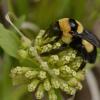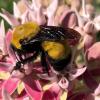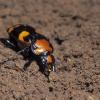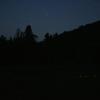
(Odonata: Anisoptera: Libellulidae)
Leucorrhinia borealis is widely distributed across much of the United States and Canada, exhibiting habitat preferences for well-vegetated ponds, bogs, and deep-water sedge meadows. Drought and water-level manipulations are the greatest immediate threats to this species, and continued global climate change will likely threaten the long-term survival of many populations. At this time, at least one known Washington population appears to have been extirpated as a result of extended drought. Because this species is unranked, critically imperiled, or possibly extirpated in all eight US states where it is known to occur (NatureServe 2008), further documentation of its range and habitat is critical for advancing our understanding of its needs and taking the appropriate conservation measures.
Adult: A small (35-40 mm, 1.4-1.6 in.) dragonfly with a dark brown or red and black body and conspicuously white face. Characteristic of the family Libellulidae, the eyes are broadly contiguous, the wings are held wide open when perched, and the anal loop of the hindwing is distinctive (foot-shaped, with a well-developed toe). Like all Leucorrhinia species, the face is white, but L. borealis can be distinguished from congenerics as follows: (1) the tops of most abdominal segments have reddish-gold shield-like spots, and (2) the spot on the 7th abdominal segment is longer than wide and extends to the end of the segment (Paulson 2007). The more common Dot-tailed Whiteface (L. intacta) has a pale dot on the 7th segment of the dark abdomen.
Immature: Leucorrhinia larvae are small, smooth and greenish in appearance with brownish markings (Bright 1998). Genus identification in the Pacific Northwest can be done using a recent key by Tennessen (2007). The following characters distinguish Libellulidae: prementum and palpal lobes cup-shaped (as opposed to flat), palpal lobe with small, regular teeth (as opposed to large, irregular teeth), head without erect, frontal horn, ventral surface of prementum without a basal, median groove. The following characters distinguish Leucorrhinia: paraprocts variable but not strongly decurved, eyes somewhat large with convergent margins of head behind eyes (as opposed to small eyes with nearly parallel head margins), distinct middorsal hook absent on segment IX and present on segment VIII, posterolateral spines of abdominal segment VIII shorter (as opposed to longer) than middorsal length of segment (Tennessen 2007). Species identification is difficult for a non-expert.
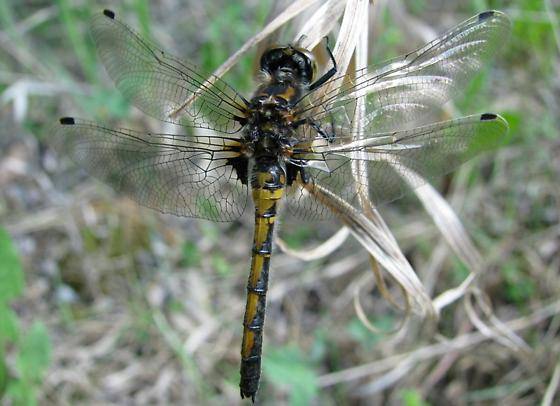
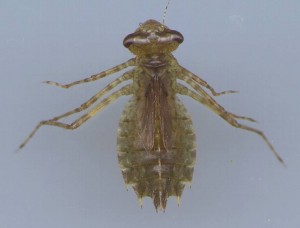
Adult flight period varies with region. In British Columbia, the adults fly early in the season, from mid-May to early August. The Washington records were collected from 14 June – 14 July. The flight period of a single adult is relatively short, lasting one week to perhaps more than a month. The majority of the dragonfly life cycle is spent as an aquatic larva, which is also the overwintering life-stage of this species. Depending on conditions, individuals may spend more than one winter as larvae, although this may be unlikely since their shallow marsh habitats often dry up. Larvae feed on aquatic animals, including invertebrates (Diptera, Coleoptera, Ephemeroptera, and Trichoptera) and possibly small vertebrates, while adults feed on flying insects (Merritt et al. 2008). Upon emergence from the larval stage, young adults (tenerals) may wander for a time before returning to their larval site or another suitable area to mate. Some adults will usually be present at locations where the species reproduces. NatureServe (2008) designates sightings more than 3 kilometers (1.9 miles) apart as separate populations, but little is known about their dispersal and colonization ability. This species is a relatively strong flier and may be a good colonist, able to reach sites a few kilometers apart.
Range-wide: In the Rockies south to central Colorado and Utah, in the upper Midwest and northern Great Plains, and Canada west and north of Ontario. Rare in the southern part of its range, but more common in the north and in parts of the northern Great Plains (NatureServe 2008).
Washington: One known site near Molson in Okanogan Co., peripheral to the main part of its range in Canada. Few surveys have been done in the surrounding area, but knowledge of only a single site suggests that it is not present at very many additional sites. It has not been found in recent years, even at the historic site (Paulson 2008, pers. comm.).
Oregon: This species has not been found and is not expected in Oregon.
Abundance: Although both site localities and population sizes are important in evaluating the distribution and stability of a species, abundance estimates for this species are not known.
Leucorrhinia larvae are common in bog lakes and marshy ponds with floating vegetation, and often exhibit unique pH and temperature preferences (Bright 1998). This species is found in a variety of well-vegetated, lentic wetlands, but may prefer deep-water sedge meadows. The larvae are climbers, adapted for living on vascular hydrophytes or detritus, and are often found lurking in vegetation or bottom debris to ambush prey (Merritt et al. 2008). Adults can occasionally be found in large numbers, perching on the bark of light-colored trees.
Global Status (1990): G5
Rounded Global Status: G5 – Secure
National Status (United States): N4?
National Status (Canada): N5
State Statuses: Alaska (SNR), Colorado (SNR), Minnesota (SNR), Montana (S1), North Dakota (SNR), Utah (SH), Washington (S1), Wyoming (SNR)
Province Statuses: Alberta (S5), British Columbia (S5), Manitoba (S3), Northwest Territories (SNR), Nunavut (SNR), Ontario (S1), Saskatchewan (SNR), Yukon Territory (S5)
(NatureServe 2008)
Drought and water-level manipulations may be the greatest immediate threats to populations of this species. The wetlands around the only known site in Washington dried up in a 2002-2003 drought, and although they are rehydrated now, the species has not been seen since. Dennis Paulson, who originally documented the presence of this species at the site, has been unable to find it during a few visits in recent years, and wonders if it is now eliminated from the state (Paulson 2008, pers. comm.). Continued global climate change will further threaten the long-term survival of this species. Projected changes in this region include increased frequency and severity of seasonal droughts and flooding, reduced snowpack to feed river flow, increased siltation, and increased air and water temperatures (Field et al. 2007), all of which could impact this species and its habitat unfavorably. Moreover, since many aspects of odonate survival (e.g. development, phenology, immune function, pigmentation, and behavior) are sensitive to changes in temperature, global climate change is predicted to have serious consequences on this taxon (Hassall and Thompson 2008). The loss of trees through timber harvest poses additional threats, since this species occupies wooded habitats, and trees provide (1) shade that maintains higher water levels and lower water temperatures for larvae and (2) foraging and nighttime roosting areas for adults (Packauskas 2005).
Since the larvae of this species are dependent on vegetation for foraging habitat and protection from predators, the alteration or degradation of this resource by herbicide application in the water or watershed is also a threat. Grazing of wetlands, recreational development, and non-point-source pollution could also threaten this species.
It is not known if disease and predation are serious threats to this species, but small populations are generally at greater risk of extirpation as a result of normal population fluctuations due to predation, disease, natural disasters, and other stochastic events.
Inventory: Follow up on the impact of the 2002-2003 drought. At a minimum, the original site and adjacent habitat should be revisited and the presence or absence of this species definitively established. Similar deep-water sedge meadows in unsurveyed territory in upland northern Washington also need to be explored for suitable habitat, and surveyed for this species (Paulson 2008, pers. comm.). Because this species is unranked, critically imperiled, or possibly extirpated in all eight US states where it is known to occur (NatureServe 2008), further documentation of its range and habitat is especially critical for advancing our understanding of its needs and taking the appropriate conservation measures. Since population size is important in evaluating the stability of a species at a given locality, abundance estimates for this species would also be valuable.
Management: All new and known sites and their associated watersheds should be protected from practices that would adversely affect any aspect of this species’ life cycle. Since the largest proportion of an odonate’s life is spent as an aquatic larva, protecting the larval stage is most critical for the species’ success (Packauskas 2005). Water quality and water levels should be maintained at the Molson site and in other potential habitat in Washington. Sites should be managed to minimize impacts from pollution, logging-related activities, and grazing. Insecticides and herbicides intended to protect the uniqueness of the biota should not be used without serious consideration of their sublethal and lethal effects on this species and other sensitive taxa in the community. In alignment with the intention to sustainably meet users recreation needs in a manner most suited to preservation of the forest system (USDA 2007), ongoing recreational development in the Okanogan National Forest should strictly avoid disturbance to areas containing the deep-water, sedge-meadow habitat of this species.
Abbott, J.C. 2007. “Leucorrhinia borealis records.” OdonataCentral: An online resource for the distribution and identification of Odonata. Texas Natural Science Center, The University of Texas at Austin 3 Oct. 2008 < http://www.odonatacentral.org>.
Bright, E. 1998. “Notes on the Michigan Species of Leucorrhinia.” 6 Aug. 1998. University of Michigan. 2 Oct. 2008 <http://insects.ummz.lsa.umich.edu/michodo/test/Leucorr.htm>.
Field, C.B., Mortsch, L.D., Brklacich, M., Forbes, D.L., Kovacs, P., Patz, J.A., Running, S.W. and M.J. Scott. 2007. Chapter 14: North America. In: Climate Change 2007: Impacts, Adaptation and Vulnerability. Contribution of Working Group II to the Fourth Assessment Report of the Intergovernmental Panel on Climate Change (Parry, M.L., Canziani, O.F., Palutikof, J.P., van der Linden, P.J. and Hanson, C.E., eds.). Cambridge University Press, Cambridge, UK. Available at: www.ipcc.ch/pdf/assessment-report/ar4/wg2/ar4-wg2-chapter14.pdf.
Hassall, C. and D.J. Thompson. 2008. The effects of environmental warming on Odonata: a review. International Journal of Odonatology 11(2):131-153.
Merritt, R.W., Cummins, K.W., and M.B. Berg. 2008. An Introduction to the Aquatic Insects of North America. Fourth Edition. Kendall/Hunt Publishing Co., Dubuque, Iowa., 1158pp.
NatureServe. 2008. “Leucorrhinia borealis.” NatureServe Explorer: An online encyclopedia of life [web application]. Feb. 2008. Version 7.0. NatureServe, Arlington, Virginia. 6 Oct. 2008 <http://www.natureserve.org/explorer/>
Paulson, D. 2008. E-mail exchange with Sarah Foltz regarding Pacific Northwest odonates.
Paulson, D. 2007. “Field Key to Adult Washington Dragonflies (Odonata).” Slater Museum of Natural History. Jan. 2007. University of Pugut Sound. 2 Oct. 2008 <http://www.ups.edu/x6518.xml>.
Tennessen, K. 2007. Odonata Larvae of the Pacific Northwest: An Identification Manual. Created for use in a taxonomic workshop sponsored by the Xerces Society and held at Evergreen State College, Olympia, Washington, March 16-18, 2007.
USDA, 2007. Okanogan National Forest News Release: Okanogan and Wenatchee National Forests seek help in planning the future of Developed Recreation Sites. 5 Nov. 2008. <http://www.fs.fed.us/r6/oka/news/2007/20070605-rec-site-developed.shtml>.
Profile prepared by Sarah Foltz Jordan, The Xerces Society for Invertebrate Conservation

